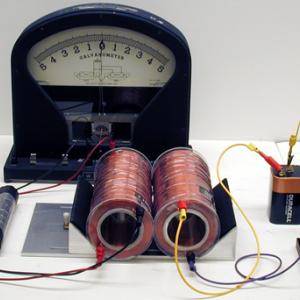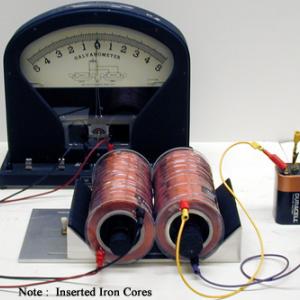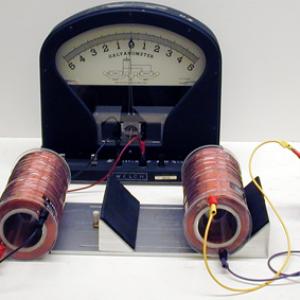College of Liberal Arts & Sciences
5K10.30 - Induced Currents using Two Coils
Video Credit: Jonathan M. Sullivan-Wood
Connect the battery, one of the coils, and the key switch in series. Connect the galvanometer to the other coil. Place the coils side by side. Depress the key switch and observe the deflection of the galvanometer. The deflection may be increased by inserting the iron core for greater classroom visibility. Note that as the switch is held down the galvanometer needle will return to zero as it is the changing of the fluxes that give the deflection. Choose your iron cores so that when both are inserted you get a full scale deflection on the galvanometer. DO NOT PEG OUT THE GALVANOMETER.
Smaller sets of nested coils and iron cores for mutual induction demonstrations are also available.
The small 3 inch diameter coil is used with the small LED's that have been mounted on small copper coils. Bring the coil near or over the LED's and observe the LED's light up.
- J. A. McNeil, "The Metal Detector and Faraday's Law", TPT, Vol. 42, # 6, Sept. 2004, p. 369.
- H. Richard Crane, "Smart Ignition Systems on Modern Cars", TPT, Vol. 24, # 7, p. 438, October 1986.
- Alfred Romer, "Faraday's Law Coils", AJP, Vol. 40, #7, July 1972, p. 1039.
- Ek - 4, 7: Freier and Anderson, A Demonstration Handbook for Physics.
- B-220: "Solenoids-Primary & Secondary", DICK and RAE Physics Demo Notebook.
- B-350: "Iron Wire Core Increases Field", DICK and RAE Physics Demo Notebook.
- Rev. J, Lukin, "Metallic Contact", The Boy Engineers, 1901, p. 341.
- Ron Hipschman, "Son of Transformer", Exploratorium Cookbook III, p. 152.1 - 152.3.
- Ron Hipschman, "Induction", Exploratorium Cookbook III, p. 146.1 - 146.4.
- W. Bolton, "Mutual Inductance", Book 4 - Electricity, Physics Experiments and Projects, 1968, p. 53.
- C.J. Overbeck, R. R. Palmer, R. J. Stephenson, Marsh W. White, "Electromagnetic Induction", Cenco Selective Experiments in Physics, 1942, p.1-4.
- The Queen Catalogues Vol. II, Catalogue of Physical Instruments, No. 5700, p. 105.
Disclaimer: These demonstrations are provided only for illustrative use by persons affiliated with The University of Iowa and only under the direction of a trained instructor or physicist. The University of Iowa is not responsible for demonstrations performed by those using their own equipment or who choose to use this reference material for their own purpose. The demonstrations included here are within the public domain and can be found in materials contained in libraries, bookstores, and through electronic sources. Performing all or any portion of any of these demonstrations, with or without revisions not depicted here entails inherent risks. These risks include, without limitation, bodily injury (and possibly death), including risks to health that may be temporary or permanent and that may exacerbate a pre-existing medical condition; and property loss or damage. Anyone performing any part of these demonstrations, even with revisions, knowingly and voluntarily assumes all risks associated with them.



